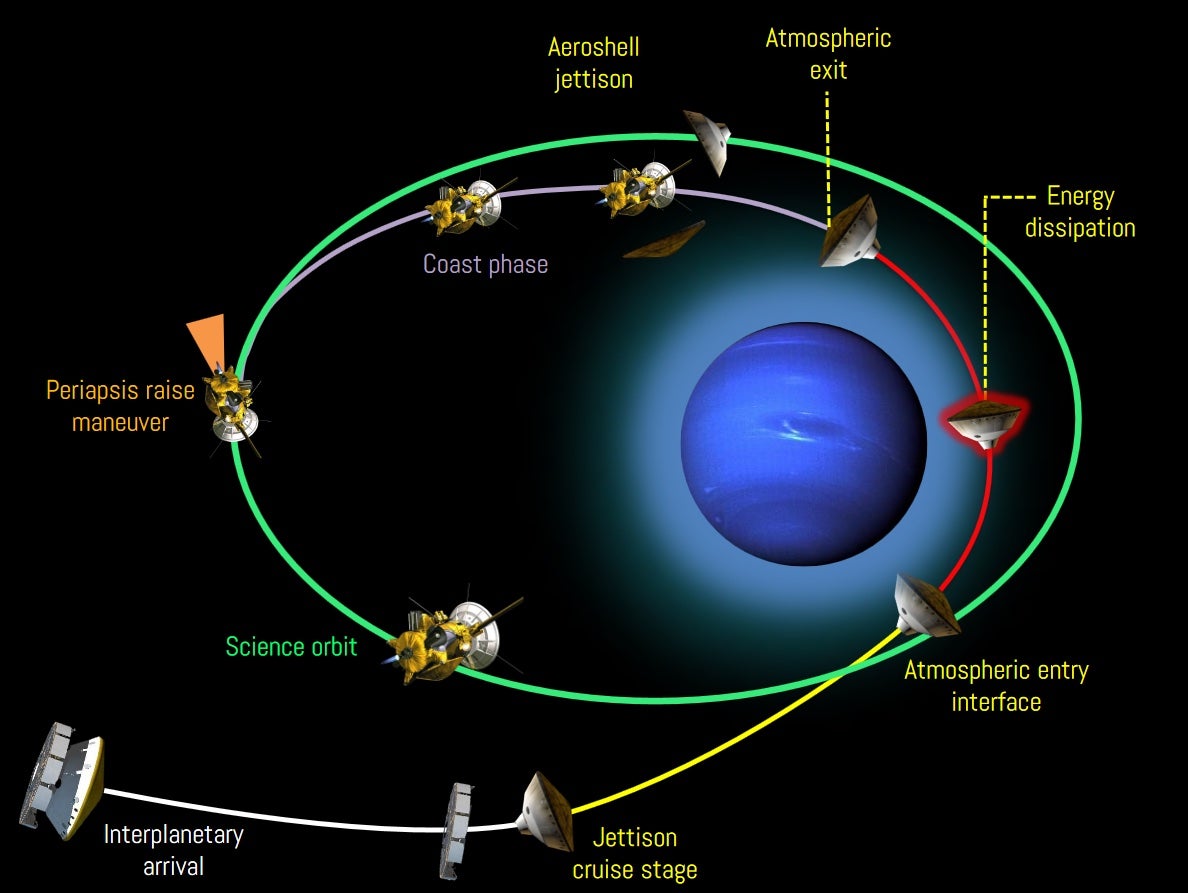
This diagram outlines the basic stages of the aerocapture technique. Credit: Athulpg007/Wikimedia Commons
Space agencies have performed a dazzling aerial feat at both Venus and Mars: they’ve dipped an incoming spacecraft into the planets’ atmospheres to slow it down without wasting precious rocket fuel.
But will this audacious aerocapture technique also work in the outer solar system? Athul Pradeepkumar Girija, who recently earned a PhD from Purdue University and now works for a private space company, seems to think so.
Detailed in a series of papers published on arXiv.org, Girija explores using aerocapture — a maneuver where atmospheric drag is used to slow down a spacecraft so it can more easily enter orbit— across a variety of outer solar system worlds, including Jupiter and Titan. But more recently, he’s turned his attention to the ice giants, Uranus and Neptune, as outlined in both arXiv.org papers and a peer-reviewed study in Acta Astronautica.
A better way to explore the overlooked ice giants
Humanity has only visited each of the ice giants, Uranus and Neptune, once. NASA’s Voyager 2 probe had fleeting encounters with Uranus in 1986 and Neptune 1989, before setting sail for interstellar space.
But recently, the decadal survey — a 10-year survey where planetary scientists and astronomers map out a future plan for the field — called for a Uranus orbiter in the coming years. While there’s no guarantee an actual mission will ever materialize, the primary goals outlined in the decadal survey do help inform space agencies about what’s important to the scientific community.
“The ice giants are of particular interest for aerocapture, as they are quite far away,” Girija says. “And if you try to use the rocket to get to orbit, it takes a lot of propellant because by the time you’re out in the outer solar system, you’re traveling quite fast.”
So, by instead using a planet’s atmosphere to help the spacecraft slow down, you can notably reduce the amount of propellant required for the trip.
“The rewards are quite high because now you don’t need to really bring 50 to 60 percent propellant with you,” Girija says. “You need to bring a heat shield with you, but often that heat shield is quite less massive compared to propellant.”
It all sounds pretty wild. After all, Voyager 2 was traveling at 39,000 mph (24,000 km/h) when it flew through the Uranus system. And the Mars Odyssey orbiter was only going a fraction of that speed when it used aerobraking at Mars in 2001.
Nonetheless, papers, including two published by JPL personnel in the Journal of Spaceflight and Rockets, back up the feasibility and benefits of aerocapture. (Girija and several colleagues also published a paper on the topic in the same journal.)
With greater risk comes greater reward
Recently, Girija looked at two ways spacecraft could accomplish aerobraking in the outer solar system: by lift and drag modulation.
Lift modulation allows a degree of control, but requires propellant to slow down, increasing the mass of the spacecraft, which cuts into how many instruments can be packed onboard.
Drag modulation relies on the fact that as a spacecraft speeds through the atmosphere of a planet or moon, friction with air molecules helps to slow it down. However, this drag method offers minimal control, and thus is a little riskier.
Girija found that both approaches can work, and each comes with its own benefits and drawbacks. But lift modulation, he concluded, allows for a higher initial entry speed, which can help shave years off the total mission time. Barreling through a planet’s atmosphere is basically a free way to significantly change the velocity of a spacecraft, Girija said. But doing so can also be a bit more dangerous than more traditional, propulsion-based approaches. “So,” he added, it’s high risk, high reward.”





